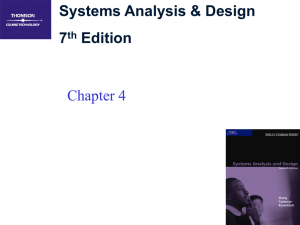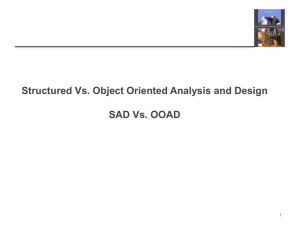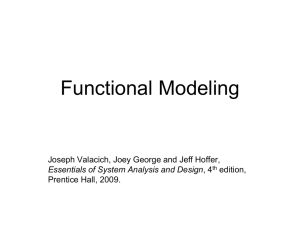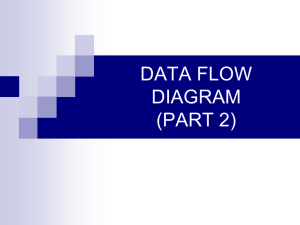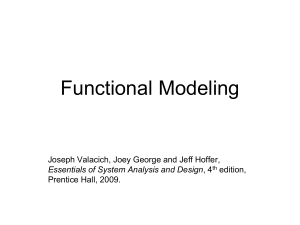Chapter 4
advertisement
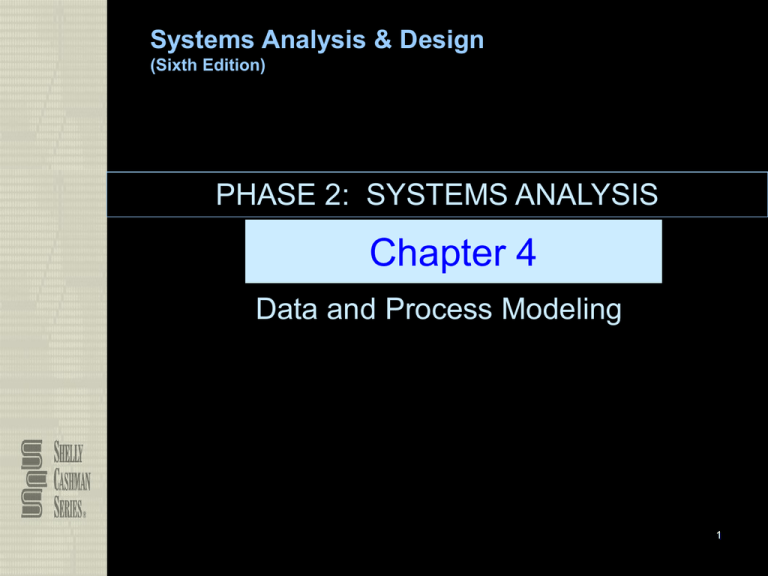
Systems Analysis & Design (Sixth Edition) PHASE 2: SYSTEMS ANALYSIS Chapter 4 Data and Process Modeling 1 Chapter Objectives Describe data and process modeling concepts and tools, including data flow diagrams, a data dictionary, and process descriptions Describe the symbols used in data flow diagrams and explain the rules for their use Draw data flow diagrams in a sequence, from general to specific Explain how to level and balance a set of data flow diagrams 2 Chapter Objectives Describe how a data dictionary is used and what it contains Use process description tools, including structured English, decision tables, and decision trees Describe the relationship between logical and physical models 3 Introduction In Chapter 4, we will use data and process modeling techniques … To develop a logical model of the proposed system Logical model WHAT system must do Physical model HOW system will be constructed (later in systems design phase) To document system requirements 4 Overview Data and Process Modeling Tools Systems analysts use many graphical techniques to describe an information system A data flow diagram (DFD) uses various symbols to show how the system transforms input data into useful information 5 Data Flow Diagrams A data flow diagram (DFD) shows how data moves through an information system but does not show program logic or processing steps A set of DFDs provides a logical model that shows what the system does, not how it does it 6 Data Flow Diagrams DFD Symbols DFDs use four basic symbols that represent processes, data flows, data stores, and entities Gane and Sarson symbol set Yourdon symbol set 7 Data Flow Diagrams DFD Symbols PROCESS symbol Receives input data and produces output that has a different content, form, or both Contains the business logic business rules Referred to as a black box 8 Data Flow Diagrams DFD Symbols DATA FLOW symbol Represents one or more data items The symbol is a line with a single or double arrowhead Fork same data 9 Data Flow Diagrams DFD Symbols Basic rules for all PROCESSES and DATA FLOWS At least 1 data flow must enter and 1 data flow must exit each process AVOID: Spontaneous generation Black hole Has no input Produces no output Gray hole Input insufficient to generate output 10 Data Flow Diagrams DFD Symbols DATA STORE symbol Represent data that the system stores Physical characteristics of data store are unimportant Concerned only with logical model 11 Data Flow Diagrams DFD Symbols Basic rules for all DATA STORES Data cannot be moved from one store to another Data cannot move from an outside source to a data store Data cannot move directly from a data store to a data sink 12 Data Flow Diagrams DFD Symbols ENTITY Symbol Symbol is a rectangle Depicts origin and/or destination of data Sometimes referred to as external entity Name of the entity appears inside the symbol AKA: Terminators final destination Source supplies data Sink receives data 13 Data Flow Diagrams DFD Symbols Basic rules for all ENTITIES (i.e. sources/sinks) Entity must be connected to a process by a data flow and not directly to a data store Data cannot move directly from a source to a sink 14 Data Flow Diagrams Basic rules for connecting processes, data stores, and entities in a DFD 15 Creating a Set of DFDs Create a graphical model of the information system based on your fact-finding results Performing three main tasks Step 1: Draw a context diagram Step 2: Draw a diagram 0 DFD Step 3: Draw the lower-level diagrams 16 Creating a Set of DFDs 1. Draw a Context Diagram Process 0 represents system 17 Creating a Set of DFDs Draw a Context Diagram Context Drawing Guidelines (Page 156, Figure 4-13) Fit on one page Name of information system Process name Use unique names within each set of symbols Do not cross lines Obtain user input and feedback 18 Creating a Set of DFDs Context Diagram Refer to Figure 4-13 on page 156 of textbook What is the name of the system in this Context Diagram? How many sources of data are there? What are they? Which entities (sinks) do not supply inputs to the Order System? What data is going into the Order System from Customer? What data is going to the Warehouse from the Order System? 19 Creating a Set of DFDs Draw a Level-0 DFD Diagram 2. Draw a Level-0 Diagram 20 Creating a Set of DFDs Draw a Level-0 DFD Diagram Level-0 DFD Drawing Guidelines (p. 161, Figure 4-16) Decomposition of Context diagram Parent/Child diagram KEEP all data flows into and out of process 0 KEEP all entities Functional primitive Diverging data flow – different locations 21 Creating a Set of DFDs Draw Lower Level 1-n DFD Diagrams Level 1-N Diagrams 22 Creating a Set of DFDs Draw Lower Level 1-n DFD Diagrams Level 1-n DFD Drawing Guidelines Leveling Balancing 23 Creating a Set of DFDs Draw a Level-0 DFD Diagram 2. Draw a Level-0 Diagram Ci1 Wo Co C2 Wi Ci2 So Bo Ao 24 Creating a Set of DFDs Draw Lower Level 1-n DFD Diagrams Level 1-N Diagrams Co Ci1 Wo 25 Data Dictionary Central Storehouse (aka Data Repository) Facts about system Data elements (aka Field) Record (aka Data Structures) 26 Data Dictionary Documenting the Data Elements Objective: Provide clear, comprehensive information about the data and processes that make up the system 27 Data Dictionary Documenting the Data Elements The following attributes are recorded and described: Data element name or label Alias Type and length Default value Acceptable values - Domain and validity rules 28 Data Dictionary Documenting the Data Elements The following attributes are recorded and described: Source Security Responsible user(s) Description and comments 29 Data Dictionary Documenting the Data Flows Typical attributes of data flows: Data flow name or label Description Alternate name(s) Origin Destination Record Volume and frequency 30 Data Dictionary Documenting the Data Stores Typical attributes of a data store: Data store name or label Description Alternate name(s) Attributes Volume and frequency 31 Data Dictionary Documenting the Processes Typical attributes of a process: Process name or label Description Process number Process description 32 Data Dictionary Documenting the Entities Typical attributes of an entity: Entity name Description Alternate name(s) Input data flows Output data flows 33 Data Dictionary Documenting the Records Typical attributes of a record: Record or data structure name Definition or description Alternate name(s) Attributes 34 Data Dictionary Data Dictionary Reports Many valuable reports may be obtained Data Element report Data Flows/Stores report Detailed reports 35 Process Description Tools A process description documents the details of a functional primitive AND represents a specific set of processing steps and business logic 36 Process Description Tools Modular Design Based on the combination of 3 logical structures Sequence Selection Iteration - looping 37 Process Description Tools Typical process tools include: Structured English Decision Tables Decision Trees 38 Process Description Tools Structured English Purpose: Describe underlying business logic Structured English Rules Use 3 building blocks Sequence, Selection, Iteration Use indentation for readability Use limited vocabulary Standard terms used in data dictionary Specific words that describe the processing rules 39 Process Description Tools Structured English (Pg. 174, Figure 4-37) Might look familiar because it resembles pseudocode 40 Process Description Tools Decision Tables Decision Tables Logical structure All combinations of conditions Resulting actions VERIFY ORDER Process 2 1 3 1. 2. 3. Conditions Combo of Y/N for condition – 4 diff. rules or combos X to accept or reject order given the rule 41 Process Description Tools Decision Tables Decision Tables Can have > 3 possible outcomes Best way to describe complex set of conditions Sales Promotion Policy 42 Process Description Tools Decision Trees Decision Trees Graph of conditions, actions, rules in decision table Personal preference Decision table or tree 43 Logical Versus Physical Models Four-Model Approach What analysts can do … 1st Create a physical model of current system 2nd Develop a logical model of current system 3rd Develop a logical model of new system 4th Develop a physical model of new system Disadvantage: Added time and cost 44 Chapter Summary During data and process modeling, a systems analyst develops graphical models to show how the system transforms data into useful information The end product of data and process modeling is a logical model that will support business operations and meet user needs Data and process modeling involves three main tools: data flow diagrams, a data dictionary, and process descriptions Data flow diagrams (DFDs) graphically show the movement and transformation of data in the information system DFDs use four symbols 45 Chapter Summary A set of DFDs is like a pyramid with the context diagram at the top The data dictionary is the central documentation tool for structured analysis Each functional primitive process is documented using structured English, decision tables, and decision trees Structured analysis tools can be used to develop a logical model during one systems analysis phase, and a physical model during the systems design phase Any questions? 46


